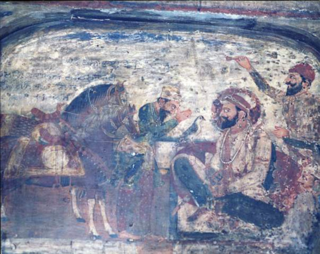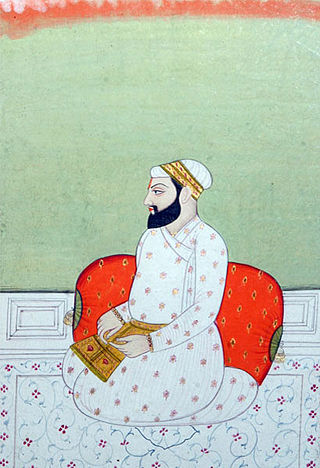
Guru Hargobind was the sixth of ten Gurus of the Sikh religion. He had become Guru at the young age of eleven, after the execution of his father, Guru Arjan, by the Mughal emperor Jahangir.

Baba Gurditta was the son of Guru Hargobind, and the father of Guru Har Rai of Sikhism. There is a gurudwara in Kiratpur Sahib, Punjab which is in remembrance of Baba Gurditta.

Mata Gujri, also spelt as Mata Gujari, was the wife of Guru Tegh Bahadur, the ninth Guru of Sikhism, and the mother of Guru Gobind Singh, the tenth Guru of Sikhism. She played a central role in the history of Sikhism and is one of the four consorts bestowed with the title of Guru-Mahal.

Doaba, also known as Bist Doab or the Jalandhar Doab, is the region of Punjab, India that lies between the Beas River and the Sutlej River. People of this region are given the demonym "Doabia". The dialect of Punjabi spoken in Doaba is called "Doabi". The term "Doaba" or "Doab" is derived from Persian دو آب meaning "land of two rivers". The river Sutlej separates Doaba from the Malwa region to its south and the river Beas separates Doaba from the Majha region to its north.
Guru Nanak founded the Sikh religion in the Punjab region of the northern part of the Indian subcontinent in the 15th century and opposed many traditional practices like fasting, janeu, idolatry, caste system, ascetism, azan, economic materialism, and gender discrimination.

Bidhi ChandChhina was a Sikh religious preacher and military commander, from Chhina Bidhi Chand village, 37 kilometers south of Amritsar and Chhina Bidhi Chand was part of Amritsar District not Lahore. His birth place temple is situated in his own village Chhina Bidhi Chand, which was built by the residents with the help of Baba Daya Singh. Baba Daya Singh laid foundation with his own hands. Every year on his birthday Baba Daya Singh, and now Baba Avtar Singh, would go to village Chhina Bidhi Chand and celebrate it there to date. He was a disciple of Guru Arjan and served Guru Hargobind for most of his life.

Ram Rai Pur is a village in Shaheed Bhagat Singh Nagar district. The village is located in the eastern part of Punjab, India. It is situated on the right bank of the Sutlej which is one of the 5 main rivers in Punjab. It is also one of the oldest villages in Punjab with a history dating back to the 17th century.
The Battle of Bhangani was fought between Guru Gobind Singh's army and Bhim Chand (Kahlur) of Bilaspur on 18 September 1686 or 1688, at Bhangani near Paonta Sahib. An alliance of Rajput Rajas of the Shivalik Hills participated in the engagement on behalf of Bhim Chand of Bilaspur State's side, including the states of Garhwal and Kangra. It was the first battle Guru Gobind Singh, the tenth Sikh Guru, fought at the age of 19.
The Battle of Anandpur was fought at Anandpur, between the armies of the Sikh Guru Gobind Singh and the Mughal forces aided by the Nawab of Bahawalpur state, Rajas of the Sivalik Hills.

Kartarpur is a town, near the city of Jalandhar in Jalandhar district in the Indian state of Punjab and is located in the Doaba region of the state. It was founded by the fifth Guru of the Sikhs, Guru Arjan.
The Battle of Rohilla, also known as the Battle of Hargobindpur, was a 1621 campaign by the Mughal Empire against the growing influence of the Sikhs.
The Battle of Amritsar was fought during Mukhlis Khan's campaign against Guru Hargobind and the Sikhs on 14 April 1634. The battle took place over two days and was a result of increasing tensions between the Mughal government and Guru Hargobind.

Guru Arjan was the fifth of the ten total Sikh Gurus. He compiled the first official edition of the Sikh scripture called the Adi Granth, which later expanded into the Guru Granth Sahib. He is regarded as the first of the two Gurus martyred in the Sikh faith.
Bhatt Kirat was a Brahmin bard in the court of Guru Arjan, whose eight hymns are present in Guru Granth Sahib, the holy book of Sikhs. The title Bhatt is given to learned Brahmins.

The Mīnās were a heretical sect of Sikhs that followed Prithi Chand, the eldest son of Guru Ram Das, after his younger brother Guru Arjan was selected by the Guru to succeed him. Prithi Chand would vigorously contest this, attracting a portion of Sikhs to his side who followers of Guru Arjan referred to as ਮੀਣੇ mīṇe, meaning "charlatans," "dissemblers," or "scoundrels." They sustained their opposition to the orthodox line of Gurus through the seventeenth century, and upon Guru Gobind Singh's founding of the Khalsa in 1699, they were declared by him, as well as by Khalsa rahitnamas, as one of the Panj Mel, or five reprobate groups, that a Sikh must avoid. They are occasionally referred to in the more neutral terms Sikhān dā chhotā mel or as the Miharvān sampraday in scholarship.

Prithi Chand, also spelt as Prithia, was the eldest son of Guru Ram Das – the fourth Guru of Sikhism, and the eldest brother of Guru Arjan – the fifth Guru. He founded the heretical Mina sect of Sikhism.

The Akal Sena was the Sikh military force established by the sixth Sikh Guru, Guru Hargobind. It was the first standing Sikh army. It was also known as the Akali Dal.
The Battle of Phagwara was fought between the Akal Sena forces led by Guru Hargobind and the Mughal forces led by Ahmad Khan.

The Hill States–Sikh wars, also known as the Sikh–Pahari Raja wars, was a set of battles and conflicts fought by the Sikhs and the rajas (kings) of the Hill States located in the Sivalik Hills.













